All information for visitors to the great island of Kalymnos
The island belongs to the Dodecanese archipelago and is just over 100 km² in size. Currently, in 2025, around 16,000 people live on Kalymnos. The island is known for sponge divers. Until a few decades ago, the inhabitants lived almost exclusively from sponge diving, agriculture and fishing. In recent years, however, tourism, which has slowly developed, has become a major source of income. Sport climbing is particularly popular on Kalymnos. There are several traditional monasteries, such as the monastery of Agios Savvas, which are worth a visit.
➔ Book hotels on Kalymnos for 2025 now at a reasonable price
Excursions to Kalymnos (day trips): There are recommended boat trips from Kos every day in summer with stops in Kalymnos, on the nearby island Pserimos and the uninhabited mini-island of Plati. In addition to the sailing trip, lunch is also included. An excellent offer for only around 30 euros. More information and booking here
Larger neighboring islands are Leros in the north and the larger island Kos in the south. Kalymnos is relatively densely populated, the island’s capital Pothia is a real city with over 10,000 inhabitants. Only the island of Kos (35,000 inhabitants) and the island Rhodes (population: 120,000) have more inhabitants than Kalymnos in the Dodecanese archipelago.
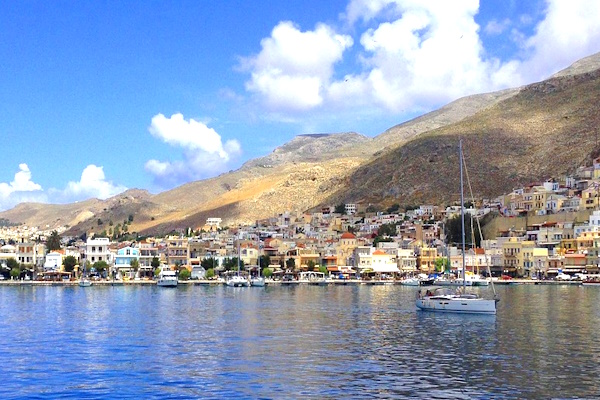
The north of Kalymnos, however, is sparsely populated. The three villages on the large peninsula in the north have fewer than 100 inhabitants. Here, holidaymakers can find peace and almost untouched nature.
The length of the island from north to south is a good 20 kilometers, from west to east a maximum of 13 kilometers. Kalymnos is very mountainous and consists mainly of limestone mountains that are difficult to access. However, the climbing tourists come precisely because of the steep limestone mountains.
➔ To book ferries within Greece, we recommend the reputable website Ferryscanner.com
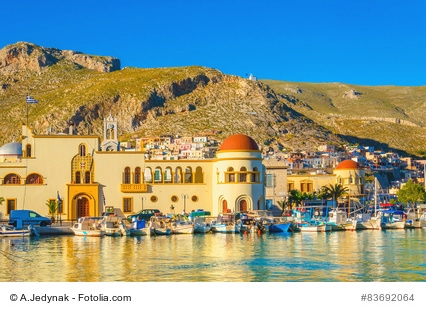
Kalymnos Economy
The island is world-famous for an unusual product: natural sponges from the seabed. A few decades ago, the majority of the inhabitants made a living from sponge diving. It was hard work. Without breathing apparatus, the island’s inhabitants dived for several minutes to depths of up to 30 meters to collect the sponges. In a few decades of the 20th century, Kalymnos was wealthy thanks to the trade in sponges from the sea. Today, sponge diving is of little importance as an industry. Above all, a disease that destroyed the sponges and the lower demand for natural sponges on the world market have made diving unprofitable.
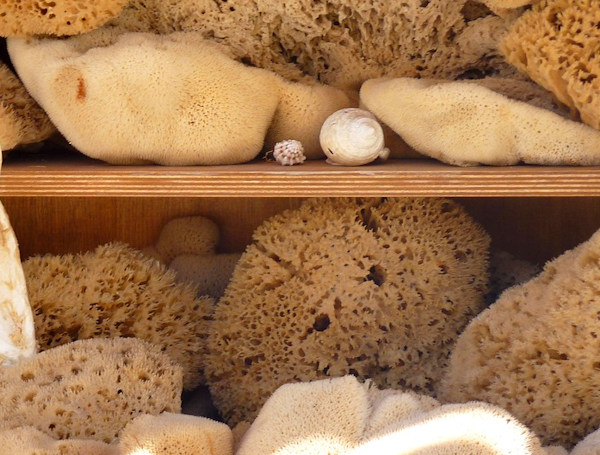
Many shops on Kalymnos still offer tourists sponges from the depths. Some residents have remained loyal to the sea. They make a living from fishing, for example hunting the large swordfish. Today, there are numerous diving centers for tourists that offer trips to underwater caves and wrecks.
Agriculture plays a relatively minor role. Citrus fruits, for example, are grown on Kalymnos. Large parts of the island are very mountainous. The limestone mountains are difficult to access and only partially suitable for agriculture.
In the last two to three decades, attempts have been made to attract more tourists to Kalymnos. This has been partially successful. There is only a very small airport on the island with no international flights. Other islands in the Dodecanese have significantly more tourism. The neighboring island of Kos has an international airport. Many tourists come from there to Kalymnos as part of a day trip.
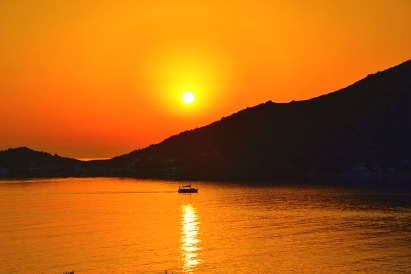
Places on Kalymnos
Pothia: The island’s capital, Pothia, is quite nice, but has no great sights to offer. The many shops that sell natural sponges are interesting. A small part of Kalymnos’ residents still make a living from the sponges. Several tons are sold to holidaymakers every year. The sponges are an original souvenir. In some of the room rentals and guest houses in Pothia you can rent cheap rooms. Most of the cafes and restaurants are around the harbor, where many yachts dock every day in summer. The islands of the Dodecanese are a popular destination for sailors. The simple taverns are comparatively cheap, Kalymnos is not a particularly rich island.
Excursions to Kalymnos (day trips): From Kos there are recommended boat trips every day in summer with stops in Kalymnos, on the nearby island of Pserimos and the uninhabited mini-island of Plati. In addition to the sailing trip, lunch is also included. An excellent offer for only around 30 euros. More information and booking here
The island’s capital has more than 10,000 inhabitants and is the only town on Kalymnos. There are several interesting museums. These include the Archaeological Museum, the Local History Museum (Folklore Museum) and the Maritime Museum of Kalymnos (English: Maritime Museum or Naval Museum). The Maritime Museum is primarily concerned with sponge diving. The equipment used by sponge divers is on display in several rooms in the “Sponge Museum”. This includes the heavy stones that allow divers to quickly descend into the depths. You can also see an antique ship, old household goods, musical instruments, furniture, boat models, anchors and much more. The Maritime Museum is perhaps the greatest attraction on the island of Kalymnos. Another attraction is Pera Castle (also Chrisocheria Castle) near the capital. It was built by the Maltese.
The place Pothia is increasingly being called simply Kalymnos-Stadt or Kalymnos-Town. The spellings Pothaia, Pothea or Potheia are also sometimes seen.
Chorio (also Chora): Like on several other islands in Greece, the old island capital is called Chorio or Chora. In the past, people preferred to live in the mountains, particularly out of fear of pirates. Since there are no more pirates, the port town of Pothia became the largest settlement on Kalymnos and later the island capital. Since Pothia is a real town and the old Chorio is only three to four kilometers from the port, the old and new capital have grown together on Kalymnos.
➔ Book hotels on Kalymnos for 2025 now at a reasonable price
Panormos: This is the second largest town on the island of Kalymnos and also not too far from the capital (less than 10 km). The beautiful beaches in and around the town attract a comparatively large number of tourists. The area around Panormos is ideal for hiking.
Myrties, Masouri and Armeos: These three adjacent towns in the west of Kalymnos are the tourist center of the island. Restaurants, room rentals, tourist shops and the like dominate the townscape for miles. The beaches are the best on Kalymnos. From Masouri, around 10 kilometers from Pothia, small boats often travel to the nearby island of Telendos (see below). Masouri has the most tourists in summer and a small nightlife.
Vathyi: This place in the east of the island is ideal for vacationers looking for peace and quiet and a charming landscape. There is a good harbor for yachts nearby. The town of Vathi (also Vathis) is the center of agriculture on the island of Kalymnos.
Emporios: A small village by the sea in the far north of the island of Kalymnos. Anyone looking for a very quiet vacation spot with a fishing harbor, a few taverns and cafes could become a fan of Emporios. The most important sight is a castle from the pre-Christian, Hellenistic period near the village of Emporios on the island of Kalymnos.
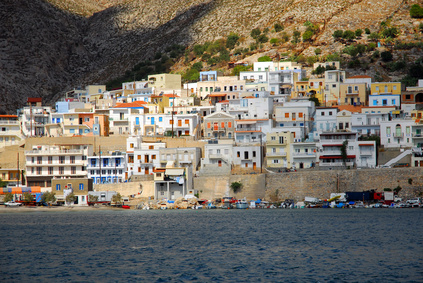 Image: Phomato – Fotolia.com
Image: Phomato – Fotolia.com
Kalymnos Top 10 List for Tourists
Kalymnos offers a mix of nature, history and adventure, ideal for active travelers.
Climbing
Kalymnos is a world-famous destination for climbers, known for its limestone cliffs and diverse climbing routes. Whether you’re a beginner or an expert, there are numerous routes to explore, especially around the villages of Massouri and Myrties.
Beaches
Myrties, Masouri and Kantouni are some of the most popular beaches. Each offers crystal clear waters, golden sand or pebbles and numerous opportunities for snorkeling and water sports.
Diving and Snorkeling
The island has a long tradition of sponge diving and underwater lovers will find plenty of marine life and clear waters. Consider diving sites such as Telendos Island or Vlychadia Beach.
Visit Sponge Factory
Kalymnos has a rich history of sponge diving and you can learn about this tradition at the sponge factories in Pothia, the island’s capital. It offers a unique insight into local culture and history.
Pothia Town
The capital of Kalymnos is a colourful, bustling town with picturesque harbour views, narrow streets and traditional shops. The Archaeological Museum and Maritime Museum of Kalimnos are a must-see.
Telendos Island
Telendos is a quiet, car-free island with beautiful beaches, scenic hiking trails and excellent snorkelling and diving spots, located just a short boat ride from Myrties.
Vathys Village
Vathys is a lush, green valley with citrus orchards leading to the picturesque Rina Bay. It is perfect for hiking, eating at a traditional taverna or taking a boat tour.
Chora
The Castle of Chora or the Castle of the Knights is a medieval fortress on a hill above Chora village. The panoramic views of the island and the sea are breathtaking.
Thermal Bath
The Therma thermal springs near Pothia are natural thermal springs that are said to have therapeutic properties.
Hiking
Kalymnos offers numerous scenic hiking trails that pass through ancient villages, mountainous landscapes and coastal areas. Trails such as Panormos to St. Savvas and Vathys to Pothia offer fantastic views and a bit of history along the way.
Map of Kalimnos (Greece)
|
The island name is usually written Kalymnos or Kalimnos. Both are correct. Telendos is only a few hundred meters from its larger neighbor and is ideal for an interesting excursion. Pserimos in the east is also inhabited (just under 100 inhabitants). The small airport Kalimnos Airport is about 3 kilometers west of the capital. The ferries dock in the city center. |
Sport climbing and hiking on Kalymnos
Sport climbing is a trendy sport – for several years now, Kalymnos has been one of the most famous climbing areas in Greece. Every year, climbing on Kalymnos becomes more well-known throughout Europe. The climbing tourists usually meet in the tourist stronghold of Masouri.
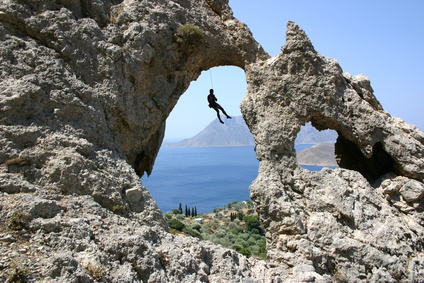 Image: Frida&Diego – Fotolia.com
Image: Frida&Diego – Fotolia.com
The limestone is ideal for climbing in many regions of Kalymnos. There are now several thousand routes for climbers with very different levels of difficulty. The sharp limestone mountains offer overhangs, steep walls and much more. The island of Kalymnos is one of the best climbing areas in Europe.
Hiking is also becoming increasingly popular on Kalymnos. You can get information and a useful map at the tourist information office. You can go up lonely mountains and valleys and have magnificent views in many places. Destinations for hikes on Kalymnos can be, for example, a remote monastery and a lonely, small beach. At some beaches you are completely alone.
Further information
Island of Telendos: The small island of Telendos is less than a kilometer from Kalymnos. In summer, a small ferry connects the tourist town of Masouri on Kalymnos with Telendos every half hour. There are frequent buses from Pothia to Maouri. This means that a day trip to Telendos in summer is possible using public transport (bus and boat). There are taverns on Telendos, rooms to rent and some good beaches within a 10-20 minute walk from the ferry dock. It is worth staying overnight – without the day tourists from Kalymnos, Telendos is even more beautiful in the evening. There are small hotels.
Kalymnos buses: In summer, the most important places in the west of the island (Myrties and Masouri) can be reached by bus from the capital Podhia around seven times a day. These buses on line 1 travel via Chorio and Panormos and end in Armeos.
There are around three buses a day to Vathi. The same number of buses go to Vlihadia. There are two buses a day to Platy Gialos (great beach). All buses start and end in the capital Pothia at the port. There are significantly fewer buses on Sundays and out of season. A timetable is displayed at the bus stop at the port.
Unfortunately, the number of buses on Kalymnos has decreased somewhat in recent years. Significantly more tourists rent a car. Rental cars are much cheaper on Kalymnos and throughout Greece than in Germany. You can also rent a moped to explore the island. If you’re very sporty, you can also try cycling.
Ferries to Kalymnos: Several connections daily in summer, some with the fast ferries (catamaran or flying dolphins) to: Kos, Leros, Patmos and the large island of Rhodes. There are also ferry connections several times a week, e.g. to the port of Piraeus, to the island of Nissiros, to the island of Symi and to Astipalea. The ferries to Athens (Piraeus) take 10 to 12 hours and run once or twice a day. From Masouri there are more than 20 small boats a day to Telendos (see above) and once a day to Leros in season.
Excursions to Kalymnos (day trips): From Kos there is a recommended sailing tour every day in summer with stops in Kalymnos on the nearby Pserimos and the uninhabited mini-island of Plati. In addition to the sailing tour, lunch is also included. An excellent offer for only around 30 euros. More information and booking here
Kalymnos Airport: There are daily flights from Kalymnos to Athens. Occasionally you can fly from Kalymnos to other islands such as Leros, Kos or Rhodes. However, Kalymnos airport is not particularly large and can only be reached by small aircraft. There are no international flights. Holidaymakers often fly to Kos and continue on by boat.
Refugees Kalymnos: It is one of the Greek islands where a large number of refugees from Turkey have arrived since 2015. However, the refugees on Kalymnos have never been a problem for tourists. They behaved peacefully and were transported to Athens by ferry 2-3 times a week. Nor have as many refugees arrived on Kalymnos as, for example, on the island of Lesbos or the nearby island of Kos.
Snakes: The mountain viper, a poisonous species of snake, is found on the island of Kalymnos. However, bites from snakes of this species (Asia Minor mountain viper, Latin: Montivipera xanthina) are rare on Kalymnos and other islands in Greece. The venom of the mountain viper is usually not fatal to humans. However, you should call an emergency doctor immediately after a snake bite. An antidote to the snake’s venom is available. The venomous snake lives on about 10 other inhabited islands in Greece, such as Kos, Patmos, Leros and Samos. Other poisonous animals include, as on almost all Greek islands, various species of scorpions.
Do you have feedback, an addition, found an error or a comment? Send us an email to: mail@griechenland-insel.de
Insel Kalymnos ( ![]() German version)
German version)